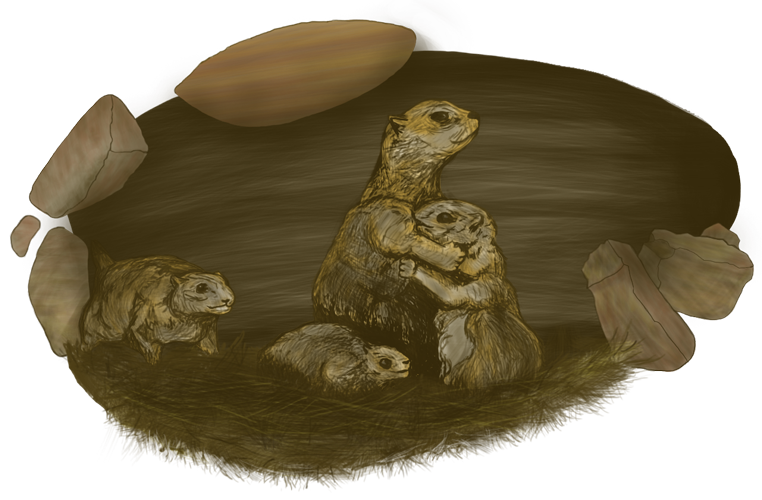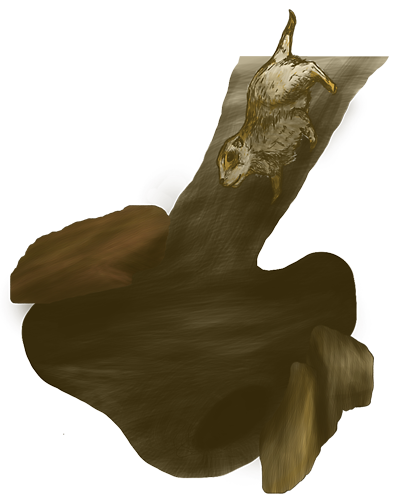Outreach
A Non-Lethal Management Guide for Gunnison’s Prairie Dogs

Gunnison’s prairie dog (Cynomys gunnisoni)—a native to the Four Corners region—is a keystone species whose burrowing and feeding habits keep prairie grasses healthy and help rainwater infiltrate deeply into the soil. Prairie dog burrows provide shelter for other species like burrowing owls, small mammals, snakes, lizards, and invertebrates. Prairie dogs are an important food source for many animals including hawks and the endangered black-footed ferret. Despite all their benefits, their burrowing and foraging can be, or perceived to be, incompatible with certain human land uses.
This handbook is a summary of humane, non-lethal methods for removing prairie dogs and preventing future colonization by using barriers. The methods described in this handbook have been developed by professionals with extensive knowledge of prairie dog natural history and hands-on experience helping landowners to create spaces free of prairie dogs. Methods are substantiated, but not scientifically proven, by the experiences of those interviewed. This handbook is an effort to provide a compilation of the best information currently available.
Downloads
On-screen version for Tablets, Smartphones, and Desktops:
Print at home version formatted for 8.5 x 11 paper:
High Resolution 6 x 9 Version for Retina Screens and Print:
RDT Field Notes Spreadsheet
This project made possible by a grant from Arizona Game and Fish Department Heritage Fund and the City of Flagstaff.

Communicating with Creatures
Rebroadcast with permission from CBC TV, Habitat Harmony, Inc.
Living with Venomous Reptiles
One of Habitat Harmony, Inc's newest board members Dr. Erika Nowak, a renown rattlesnake bologist, brings a new area of expertise to Habitat Harmony.
Erika is passionate about using the results of scientific research to teach people to live in harmony with venomous predators and other wildlife. Attached is the "Living with Venomous Reptiles" brochure.
The “Living with Venomous Reptiles” brochure, produced by the Tucson Herpetological Society in cooperation with the Arizona Game & Fish Department, was designed as an educational tool to help acquaint the public with basic information on venomous reptiles in Arizona. The brochure's production was funded with a grant from the Arizona Game and Fish Department Heritage Fund. The Arizona Game and Fish Department Heritage Fund receives its money from the Arizona Lottery.
Download a pdf copy of the "Living with Venomous Reptiles" brochure.
Download a pdf fact sheet about the Arizona Black Rattlesnake.
Download a pdf fact sheet of "Reducing Rattlesnake - Human Conflicts."
Our Prairie Dog Neighbors

“Our Prairie Dog Neighbors” brochure, produced by Habitat Harmony, Inc. in cooperation with Northern Arizona University and the Arizona Game & Fish Department, was designed as an educational tool to help acquaint the public with basic information on Gunnison's prairie dogs. The brochure's production was funded with a grant from the Arizona Game and Fish Department Heritage Fund. The Arizona Game and Fish Department Heritage Fund receives its money from the Arizona Lottery.
Click on the pages below to download a pdf copy of the current brochure.
Tutored By Prairie Dogs
by Sherry Golden

I have two pet prairie dogs even though I am against ownership of exotic pets. I work with a local animal activist group called Habitat Harmony, Inc. Habitat's projects include relocating prairie dogs from areas where they are not wanted. This past summer we captured prairie dogs from the site where the new city fire station would be built.
Habitat also has an education program, taking presentations on the prairie ecosystem to young people and adults. We had thought that if the right circumstances ever materialized, we might keep a couple of prairie dogs for the education programs. They would be scientific props, visual aids, teaching tools. To that end, I obtained a Wildlife Holder's Permit with the Arizona Game & Fish Department. Then this summer we caught 2 very young juveniles without adults, and knowing that we could not release them, we decided to keep them. Of course, for educational purposes.
Ambassador Feisty Britches, a female, and Mr. Bo Jangles, a male, moved into my home. And then the education began.I was the one being educated!















